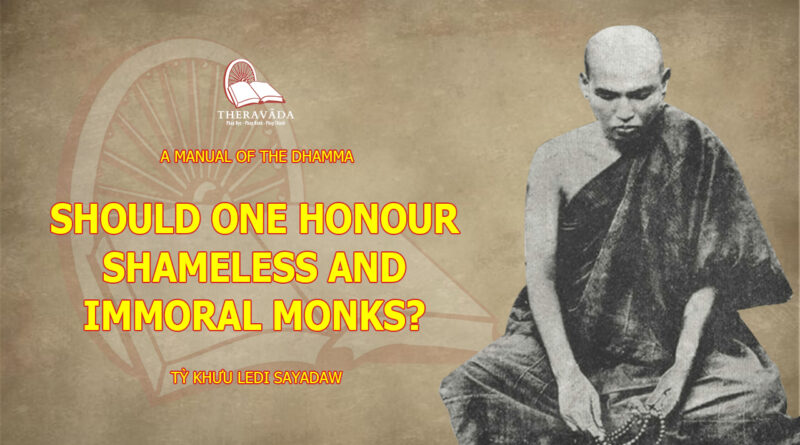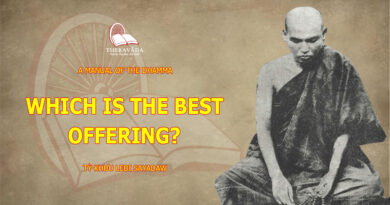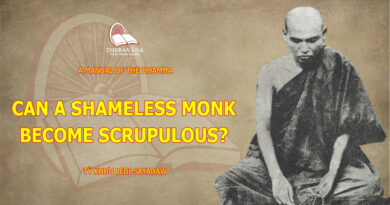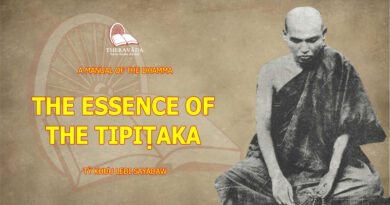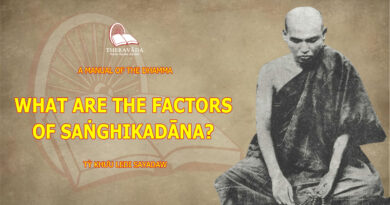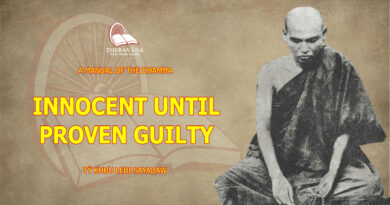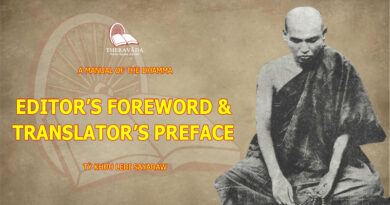Should One Honour Shameless and Immoral Monks?
“If a person, knowing a monk to be shameless or immoral, offers the four requisites, does this amount to the blessing that says that one should honour worthy persons? Or does it contradict this advice? Kindly let us know the good or bad results with suitable evidence and case histories.”
First one should know the persons worthy of honour as mentioned in the Suttanipāta Commentary. They are 1) the Omniscient Buddha, 2) a Pacceka Buddha, 3) a Noble Disciple, 4) one’s mother, 5) one’s father, 6) one’s elder brother, 7) one’s elder sister, 8) the mother of one’s husband, 9) the father of one’s husband, 10) the elder brother of one’s husband, 11) the elder sister of one’s husband.
This Commentary mentions only eleven types who are worthy of honour and respect. The Commentary on the Dakkhiṇāvibhaṅga Sutta further mentions that, for householders who take refuge in the Three Gems, novices, monks, and Noble Ones are worthy of honour and respect. In classifying persons who are worthy of honour we should therefore include the following: 12) an ordinary householder who accepts the three refuges, 13) an ordinary householder who maintains the five precepts, 14) an ordinary novice, 15) an ordinary monk. Thus, fifteen types of worthy persons can be found.
For ordinary novices and monks we can define three further classes: scrupulous (lajjī), shameless (alajjī), and immoral (dussīlo).
Offering almsfood and other requisites to scrupulous novices and monks amounts to the good practice enjoined in the Maṅgala Sutta as “honouring those worthy of honour.” One may doubt whether offerings to shameless or immoral novices and monks fulfil the Maṅgala Dhamma or not. The answer is that offerings to shameless novices and monks do amount to honouring those worthy of honour. The only problem to consider is whether we can classify offerings to immoral novices and monks as an auspicious deed. Many lay supporters find themselves in perplexity here. So I should give the answer in detail for clarification and guidance.
In the Visuddhimagga it says that every monk, once ordained, bears the burden of more than nine billion Vinaya rules.⁸ In the five Vinaya books explaining the Pātimokkha saṃvara sīla, the Omniscient Buddha proclaimed innumerable rules for all monks. So every monk in this dispensation undertakes innumerable precepts and training rules, which he must learn and follow. Once the three refuges and kammavācā recitations have been completed, every monk has accepted the innumerable rules of basic monastic restraint (Pātimokkha saṃvāra sīla).
The Omniscient Buddha’s power of making Vinaya rules and regulations for all monks is based on “Ānādesanā” — his authority or command. So once a layman receives the robes from his preceptor, he automatically transcends a layman’s status and instantly becomes a homeless one. Even at the initial stage of ordination, a candidate is worthy to receive homage and alms from lay donors. This is due to the status received from the mandatory law of the Vinaya. Lay people should show their respect by bowing, though the candidate has not yet undertaken the novice rules and regulations. At the third round of reciting the Three Refuges he automatically undertakes the novice rules and regulations. Then he is a real novice and needs no further taking of precepts as he has undertaken them automatically after the completion of the ordination procedure.
If this fully ordained novice breaks one of ten main rules,⁹ he destroys the status of the Three Refuges, thereby forsaking all rules of one gone forth. What remains are the asking and taking of the robe, so he has not yet reverted to the status of a layman. He is still a novice according to the Vinaya. However, he is not a true novice of the type mentioned above as he lacks the training rules. If, however, he takes the Three Refuges from the Saṅgha again, he undertakes the training rules again. Only if he fails to take the Three Refuges from the Saṅgha can he be classified as immoral, since he falsely claims to be a novice. If he does not take the Three Refuges again, he is an immoral, fallen novice. If he admits his faults, he is not classified as immoral, and he becomes a layman by this act.
Many lay people think that if a novice breaks one of the ten main rules he automatically becomes a layman. This is wrong. If the act of taking up the robes is retained, he cannot be classified as a layman. The matter of disrobing for the transgression is not the responsibility of the preceptors or teachers. The decision rests with the novice concerned. What preceptors and teachers can do is to expel an immoral novice from the Buddha’s dispensation. These explanations are in accordance with the Vinaya text¹⁰ and decisions in the Commentaries. This explains the nature of an immoral novice.
Besides the ten main disciplines, a novice has to observe ten punishments and seventy-five training rules, which are classified as “offences” or “punishments.” So if a novice transgresses one in this class, no failure of the Three Refuges arises, there is no destruction of the precepts either. What fault he gets here is the breaking of restraint only. This type of offence can be cured by undergoing punishment, after which he regains his purity of restraint as before.

